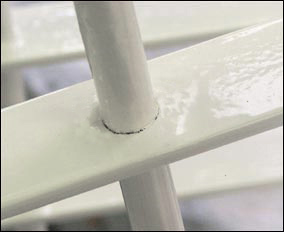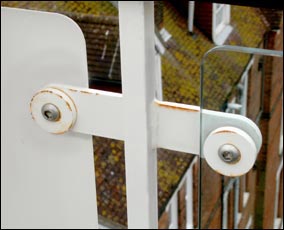Improve design to avoid corrosion
Protect from rust - The following are examples of common fabrication design faults:

Water traps
The railing shown was not welded on the top of the upright. Although we have applied over 200 microns of paint in this area in order to fill the gap, we have not been totally successful. Water will flood and remain in the dark areas shown, and because there is no paint will rust within a year. On design and manufacture, all water traps should be avoided. This job could have been galvanized; the zinc would have filled the cavity. If like this job, it's a bit late, try filling the cavities with a sealant or thick wet paint..

Sharp edges
This was a job we were asked to look at within view of the sea. It had been on site for nearly two years and rust was beginning to show. Two problems, generated by the desire to have a smooth finish; the material was not galvanised which is advisable when requiring white, as a pinhead of rust will leave large brown stains on a contrasting background. The second problem were the areas where the rust has occurred have been laser cut leaving sharp edges. It can be seen that only these edges are failing, not the flat areas. Powder wraps very well round curves but it does not cover well over spikes and sharp edges. These sharp edges should have been rounded off.

Securing mesh
The mesh has been trapped between the inside flat of an angle iron and a strap. This has presented us with two problems. We cannot get paint between the two flats and around the mesh, and a water trap has been generated. Water will collect in these areas and without any paint will definitely rust, in a matter of weeks. We would expect brown rust marks to run over the fresh paint. Shortly after the paint will begin to lift as the rust will creep underneath. If like this job, it's a bit late, try filling the cavities with a sealant.